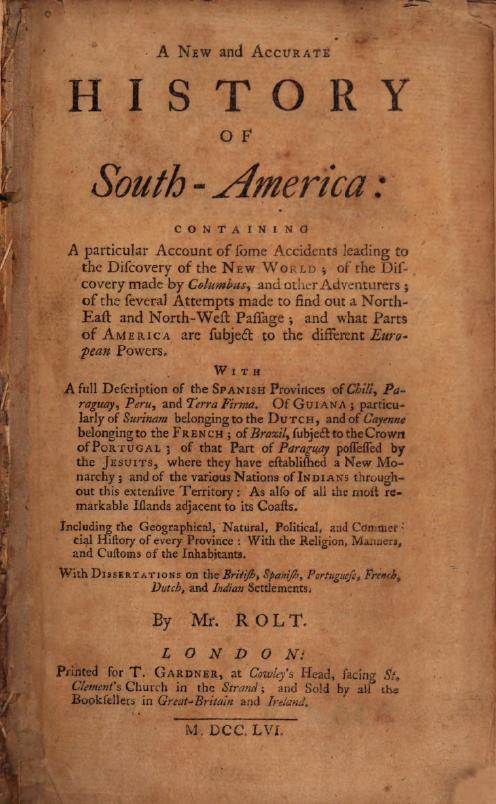|
 |
. . . .
Section II.
A description of the principal islands upon the coast of Peru; as also of the Gallapagos, and the islands of Solomon. . . . .
|
. . . .
1. The GALLAPAGOS, or Gallipago islands, that is of tortoises, are a great number of uninhabited islands, in about 90 degrees of west longitude; lying under, and on both sides of, the equator; being 110 leagues from the northern part of the continent of Peru, almost opposite to Cape Passao, and the town of Quito. The Spaniards, who first discovered them, and in whose draughts alone they are laid down, report them to be a great number, stretching north west from the line, as far as five degrees north: but Dampier says, he saw only about 14 or 15; some of which were 7 or 8 leagues long, and 3 or 4 broad; being tolerably high, and flat on the top. Four or five of the eastermost islands are rocky, hilly, and barren; producing neither tree, herb, or grass, except by the sea-side, and a few dildoe trees within land, which are green prickly shrubs, that grow about 8 or 10 feet high, without leaf or fruit, and not so much as fit to burn: but close by the sea there are bushes of burton wood, in some places, which are good for firing: however, there is water upon these barren islands, in ponds and holes, among the rocks. Some other of these islands are mostly plain, and low; the land more fertile, and producing trees of several sorts, unknown to Europeans; particularly some of the westermost islands, which are 9 or 10 leagues long, and 6 or 7 broad: having a deep and black mould, that produces trees of great and tall bodies, especially mammee-trees, which grow here in extensive groves. In some of these larger islands, there are pleasant rivers; and |
there are brooks of good water on several of the lesser islands: but they all abound with guanoes, and land turtle, or tortoise; the former being fat, large, and tame; and the latter are so numerous that 5 or 600 men may subsist on them alone for several months. Some of these land-turtle are 150 or 200 lb. weight; and so sweet, that no pullet eats more pleasantly, if Dampier is to be credited. There are some green snakes on these islands; and great plenty of turtle-doves, which are tame, and somewhat less than a pidgeon; but good meat, and commonly fat. There are good wide channels between these islands, fit for ships to pass; and shoal water, in some places, where there grows plenty of turtle-grass; therefore, these islands are also plentifully stored with sea-turtle, of that sort which is called the green-turtle: for there are these four kinds of sea-turtle; the trunk-turtle, the loggerhead, the hawksbill, and the green turtle; the latter of which is so called because its shell is greener than any other, but extraordinary thin, and used only for inlays. One of these green turtle will generally weigh from 2 to 300 lb. their backs are flat; their heads round and small; being the sweetest of all the kinds: but there are degrees of them, both in respect to their size and their flesh. Green turtle live on grass, which grows in the sea, from 3 to 6 fathom water, about a quarter of an inch broad, and 6 inches long: but the turtle of these Gallapago islands, according to Dampier, are a sort of bastard green turtle; for their shell is thicker than those in the East or West Indies; nor is their flesh so sweet and wholsome. Both males and females |
come ashore in the day time, and lie in the sun, upon these islands: but, in other places, only the females go ashore, and in the night, to lay their eggs. There is plenty of salt in these islands; and the sea about them is well stored with excellent fish: but there are also abundance of sharks. These islands were discovered, and described, by captain Cowley, in 1684; who calls them by the names of, King Charles's island, Crossman's island, Bruttle's island, the Duke of Albemarle's island, Narborough's island, Cowley's Inchanted island, King James's island, Dean's island, Duke of Norfolk's island, Dassigney's island, Albany island, Euress's island, Bindos's island, Earl of Abingdon's island, Lord Wenman's island, and Lord Culpeper's island. The air of these islands is temperate enough, considering the climate; for there is constantly a fresh sea-breeze all the day, and cooling refreshing winds in the night: therefore, the heat is not so violent here, as in most other places under the equator. The rains fall in November, December, and January; when there is frequently excessive dark tempestuous weather, mixed with much thunder and lightening: sometimes, before and after these months, there are moderate refreshing showers: but, in May, June, July, and August, the weather is always very fair. . . . .
|
|
Source.
Richard Rolt, 172?-1770.
This publication may be found at Hathi Trust.
Last updated by Tom Tyler, Denver, CO, USA, December 28, 2024.
|
|